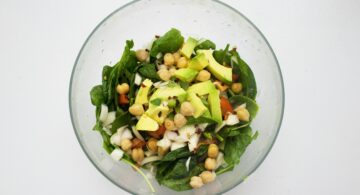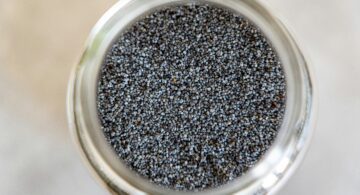Food for Joint Pain
I’ve often heard people chalk up their joint pain and stiffness to their increasing age. Many people believe that joint pain is just part of the territory as we get older. However, with the proper diet, we can prevent, slow, or even stop joint pain!
Although many people are diagnosed with rheumatoid arthritis, not all joint pain is caused by this devastating autoimmune disease. Believe it or not, the cause may lie entirely in what you eat!
Certain foods can actually cause joint pain. The reason why isn’t always clear, but many times these substances seem to aggravate our body. This aggravation can result in unpleasant pain, inflammation, and stiffness. It is almost as if your body is telling you that it’s angry when a certain food is put into your body.
Now, your job is to simply listen to your body’s cry for help by eliminating those foods and replacing them with healthy alternatives.
Sugar and Joint Pain
No one likes seeing sugar on the list of foods that are bad for us. But, you just can’t hide from it. Sugar can cause all kinds of diseases ranging from diabetes to cancer. Unfortunately, it can cause joint pain and stiffness, as well. You may love that sweet taste on your lips, but your body may be crying out in pain.
There is a particular process that occurs in your body when you eat foods high in sugar. It is this process that leads to pain in your joints:
- Eating sugar leads to rapidly elevated blood sugar…
- Which leads to a rapid release of insulin…
- Which leads to your body reacting with an immune response…
- Which can lead to systemic inflammation…
- Which can lead to joint pain and stiffness…
It may sound a bit harsh, but consuming a lot of sugar is toxic. No, it doesn’t kill you instantly. But it slowly chips away at your health a little at a time. It may go unnoticed, at first. But as time passes, you are left in the end with pain or disease.
Avoiding all sugar is best. But the top sweet health-busting contributors to stay away from are:
- High fructose corn syrup
- Sucrose
- White sugar
- Glucose
I recommend using safe sweeteners like:
- Honey (in moderation)
- Coconut sugar
- Xylitol
- Stevia
If you’d like more information on safe alternatives to sugar, then check out this article devoted entirely to safe sweeteners.
Artificial Sweeteners and Joint Pain
As you can see above, I didn’t mention artificial sweeteners on my list of safe sweeteners. That was for a good reason! Artificial sweeteners are far worse than sugar! These lab created chemicals have often been linked to joint pain, muscle pain and stiffness. Some people have even experienced symptoms of full-blown MS (multiple sclerosis) from consuming artificial sweeteners! And that, unfortunately, isn’t all.
There is a long laundry list of diseases that can be caused by artificial sweeteners, including many forms of cancer! The most common artificial sweeteners on the market are:
- Aspartame (Nutrasweet)
- Saccharine (Sweet and Low)
- Sucralose (Splenda)
You can look at the science behind why these sweeteners are so toxic to the body. But it boils down to something very simple to understand —- they’re not real food! Anytime you put some sort of unnatural product in your body, you’re likely to have unnatural side-effects. A great example is the long list of possible side-effects listed on every pharmaceutical and over-the-counter drug.
- Saccharin is a potential carcinogen that is linked to bladder cancer.
- Aspartame is linked to depression, cancer, headaches and increased hunger, to name a few. Over consumption even has a name: aspartame poisoning, which includes joint pain as one of its symptoms.
- Sucralose – discovered while creating a new insecticide and is widely associated with gastrointestinal problems, cutting the population of the good bacteria in your gut in half within a few weeks.
- Acesulfame K, while lesser known, is also a carcinogen. It’s long term use leads to a host of problems, including mental decline, cancer, liver and kidney problems, as well as headaches and depression.
I highly suggest you remove all artificial sweeteners from your diet. Not just to help with your aches and pains, but for your overall health!
Saving calories isn’t worth when it comes to these chemical sweeteners! Sweeteners are not essential nutrients in our diet, so they exist to nurture our sweet tooth, not our bodies. Remember, there is nothing in our diet that we can consume without a cost.
Caffeine and Joint Pain
We live in a society absolutely addicted to caffeine. Energy drinks, coffee shops, and chocolate are everywhere! Although consuming caffeine in moderation doesn’t typically cause any health issues, over indulging can cause joint pain. And by over indulging, I mean more than one cup of coffee a day. Don’t forget that soda and decaf coffee contain caffeine, as well!
There is no definitive research as to why caffeine can cause joint pain. However, some believe it is because caffeine is such a strong diuretic. Diuretics can cause systemic dehydration, which can lead to a buildup of uric acid. This causes a painful condition of the joints called gout. Also, dehydration of the joint itself can occur causing stiffness and pain. Many people have seen significant reduction in joint pain by eliminating caffeine. It is definitely worth giving it a try!
Food Allergies and Joint Pain
When people think of a food allergy, they typically associate it with digestive upsets or anaphylactic shock. But not all food allergies manifest in the same way. There are people who may go their entire lives not knowing they have a food allergy because it’s manifestations aren’t typical. They are still having an immune response, even if mild. Although it is not as noticeable as other allergies, this subtle reaction can cause inflammation and pain in your joints!
Food allergies can develop at any age. Your body may have tolerated a food most of your life, but eventually your immune system begins to overreact. Inflammation is a very common immune response to food allergens. Hives, bloating, and itchy watery eyes are all manifestations of the inflammatory response in our bodies.
However, an inflammatory response can also manifest in your joints. After all, an allergic antibody can attached itself to any tissue in the body. If it affixes to your joints, the offensive food can cause worsening joint symptoms. Pain, swelling, and damage to your joints can occur entirely based on a food you’re eating! What is amazing is that if you eliminate that food, your pain can be entirely resolved!
Maybe your joint pain isn’t constant. You may notice an increase in pain that later decreases. You might have had no idea that there is food association. You can have an allergy test performed by your doctor, but they aren’t always accurate.
Keeping a food log is a great way to identify particular culprits. I also recommend eliminating high allergen foods for at least 3 weeks and slowly introducing them back into your diet one at a time. Below, I will cover the most common joint aggravating food allergen culprits.
Gluten and Joint Pain
One of the most common of all food allergies is gluten. Gluten is a component of several grains including wheat, barley, and rye. It is estimated that 1 out of 133 people have one of the most severe forms of a gluten allergy called Celiac disease. However, you don’t have to be a full-blown Celiac to be sensitive to gluten. Some doctors and researchers are estimating that as many as 50% of Americans may fall somewhere onto the spectrum of gluten disorders!
Although many of the manifestations can be gastrointestinal, many possible side-effects include headaches, foggy thinking, numbness in fingers, arms and legs, fatigue and…you guessed it…joint pain.
Luckily, because of the rapid rise in gluten disorders there has also been a rise in gluten-free food alternatives. I personally struggle with a mild gluten sensitivity and have relied on gluten-free products for years. My personal favorite is using rice noodles as a substitute in pasta dishes. You can hardly tell a difference! Quinoa is another delicious grain that is high in protein, as well as gluten free.
Milk Products and Joint Pain
I know you don’t want to hear it. First wheat and now milk!! You’re thinking, “What is there left to eat?” First, I must say that these are “possible” allergens. And to be honest, if you are allergic, you will love how you feel when you don’t eat them much more than you love the taste in your mouth!
There is a difference between a milk allergy and lactose intolerance. Lactose intolerance is when you lack the enzyme, lactase, which breaks down lactose. Most of the symptoms of lactose intolerance are gastrointestinal. A milk allergy is far less common than lactose intolerance, but is still a common food allergy.
And like any food allergy, milk can cause a flare up of swelling in the joints. There are numerous testimonies online that have restored pain free joints through the elimination of milk from their diet and break the inflammatory cycle. Imagine, you can move like a teenager again simply by choosing to avoid dairy!
Like wheat, there are now many milk alternatives on the market. Almond and coconut milks are the healthiest choices. I would highly advise against consuming soy milk products, as soy is a high allergen food, as well.
Peanuts and Joint Pain
Again, when we think of a peanut allergy, we imagine an “emergency situation.” But, you could have a slight allergy to peanuts and have no clue! Does anyone in your immediate family have a known peanut allergy? Because genetics play such a strong role in allergies, they often run in families. If your brother, sister, mom or dad, or one of your children has a peanut allergy, then you may very likely have one, as well! You may have assumed because you don’t go into anaphylactic shock when you have a PB&J that you’re out of the woods. Not so! Your allergic response may be more mild, but it can still cause body discomforts like joint pain.
Peanuts also often have mold. You may not taste it or see it, but it’s likely there. So, it may not even be the peanut causing your mild allergic reaction and possible joint pain, but the mold that it contains. Peanuts are also high in linoleic acid, an omega-6 essential fatty acid, which can increase your inflammatory response, causing pain, stiffness and swelling in the joints.
Peanuts, thankfully, are quite easy to eliminate. I recommend almonds instead. They rarely have mold and are far less likely to be an food allergen. Imagine, getting off or stopping pain medication could be as simple as avoiding peanuts!
Artificial Everything
Earlier in the article, I touched on artificial sweeteners and their toxic effects on the body. However, most anything artificial that you put inside your body has the potential for causing an allergic response, which can directly affect joint pain.
Again, it’s quite simple. If it’s artificial, then your body isn’t going to recognize it as food. Your immune system will instead see foreign invaders and the allergic and inflammatory responses will begin. The pain in your joints will be aggravated by simply daily activities, thereby reducing your mobility and flexibility.
There is truly no way around it. Our body is hard-wired to react to foreign substances in our body. But the remedy is easy. The natural way to relieve the discomfort is to eat real food! No more artificial colors, flavors, or preservatives. Chances are if you can’t pronounce it, then it isn’t a real food. Always read the labels on your foods. You never know what can be hiding in what you eat!
Overall, you can’t go wrong by favoring simple, whole foods as opposed to processed convenience foods.
Healthy Joints from Healthy Foods
Now that I’ve told you what foods can cause or contribute to joint pain, I’m going to give you a quick guide to what foods can help joint pain! The best foods for your joints contain one or more of these nutrients:
- Antioxidants
- Anti-inflammatory agents
- High levels of vitamins and minerals
- Healthy fats
The best way to pack your diet full of foods high in vitamins, mineral, antioxidants, and anti-inflammatories is to eat a colorful diet. Some of the most nutrient dense foods have the most pigment dense colors! Some of these natural weapons for joint pain include:
- Leafy Greens
- Beets
- Turmeric (a spice high in anti-inflammatory properties)
- Blueberries
- Avocados
- Sweet potatoes
- Broccoli
- Pomegranates
The more fruits and veggies you pack into your diet, the more pain reducing nutrients you are putting into your body!
Healthy fats, specifically omega-3s, are scientifically proven to improve joint pain. My favorite sources of omega-3 fats include:
- Sardines
- Salmon
- Chia seeds
- Flax seeds
By altering what you eat, you can expect positive changes in your health, and your joints, with life saving benefits for the rest of your life.
Recipes for Joint Health
As I mentioned earlier, quinoa is a grain that is not only gluten free, but also very high in protein. One cup has twenty-four grams of protein! As its popularity has grown it’s becoming easier to find quinoa on grocery shelves. This grain is well tolerated and easily digested. I have seen it used in everything from chili recipes to middle-eastern dishes.
One of my favorite ways of preparing it is in a salad. You can add your favorite vegetables and modify it to your taste. It is both fast and easy to prepare and would be a great gluten-free dish to bring to potluck dinners!
Colorful Quinoa Salad
Ingredients
- 4-6 cups of prepared quinoa that has been chilled (prepare according to the package directions)
- 1 red bell pepper
- 1 orange bell pepper
- 1 head of broccoli
- A couple handfuls of grape tomatoes
- 6 green onions
Directions: Dice your vegetables and toss with the quinoa grains. Pour on the dressing right before serving and toss lightly.
Dressing
Ingredients
- ¼ cup of olive oil
- 1 tbsp of organic apple cider vinegar
- 2 tsp of all-purpose seasoning like Spike or Braggs
- 1 tsp of salt
- 1 packet of stevia
Directions: Whisk together until well blended.
When it comes to changing our diet, we often forget about the little things. However, some of the worst ingredients can hide unassumably in our everyday condiments!
Jams and jellies are not only packed with sugar or corn syrup, but some even contain artificial colors and flavors. Below, is a lightly sweetened strawberry jam that uses omega-3 containing chia seeds as the thickener. I think you’ll love the results and your body will thank you!
Strawberry Chia Jam*
- 2 cups strawberries – cleaned and chopped
- 1 cup water
- 1/4 cup chia seeds
- 1/4 cup honey
Directions:
- Place all ingredients into a metal pot and bring to a boil.
- Reduce heat slightly so the contents of the pot don’t splatter all over your stove, but still bubbles in the pot.
- Stir constantly! The chia seeds burn on the bottom of the pot very easily.
- Stir and boil until the mixture has reduced by half and has thickened. Again, it will not be as thick as jam, but it still definitely thickens.
- Pour into a clean glass jar and allow to cool for 1 hour. Place in the fridge overnight to continue cooling.
Throw out that artificial food and instead fill your diet with beautiful, colorful, low allergen foods. You won’t only see a reduction in joint pain, but an improvement in your overall health! Food truly can be medicine for the body!
A pain in your joints and can aggravate the smallest daily activities, leading to reduced mobility and flexibility of the body. But by fueling your body with natural anti-inflammatory foods, and keeping away from any food allergies, you can keep your joints flexible and well-nourished.
After reading this article, can you identify the problem foods in your diet? If so, what are they?
*Recipe adapted from www.thegraciouspantry.com






















